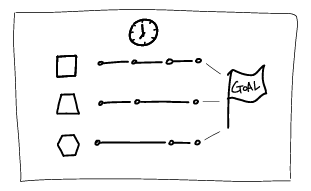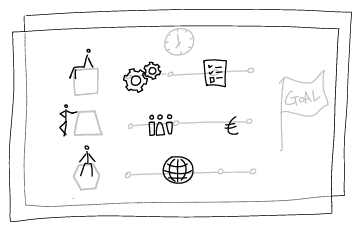Lead with Frames
How to deal with Conflicts and Complications in Business
Whether you are growing into senior leadership in an organisation or your business is growing faster than it can adapt to, with all the great opportunities coming your way, you are probably facing the two challenging signs of a fast-growing business: Conflict and Complication.
These are natural byproducts because you are dealing with tougher targets, the business has more elements to consider and you have various levels of stakeholders who are not necessarily always on your side.
If you are in the position of working with multicultural, multinational teams and counterparts, the symptom is even more noticeable. Someone from another part of the world might hold you back saying that they have different priorities than yours, that the legal requirement is different in their region, or they might not even pay attention to your approach.
You may find that everyone seems to have a different agenda and priority, even if they work for the same company as you. They think differently, talk differently, react differently, debate differently and even collaborate differently.
When you want to drive heavy lifting strategic projects, you will find that there are many causes and effects to take into consideration on top of the business strategy itself: The correlation amongst legal, audit, financial impact, capabilities and capacities of resources, and logistical practicality and so on.
A good intention alone is not enough to drive topics with variety of stakeholders.
Key to the solution
Then what is the clue to overcome these symptoms to lead the business successfully without losing people?
I would like to shed light on “Critical Angles of Business(CAB)” and the “Framework”. What are the Critical Angles of Business(CAB)? A Vision, Roadmap and Enablement.
-

Vision
A vision should be purposeful in order to express a company’s existence and be aspirational enough to look up to, like a sun! It is an ultimate anchor point for everyone and every decision made. A purposeful vision also provides a principle for setting up clear goal(s)*: A tangible outcome to realise the vision into a reality.
If you are an employee and your company already has a vision statement, find a link to your role and responsibilities. If you are a leader of a company, focus on translating your company’s vision into a team’s or an individual’s vision.
*Goal - I will not go deeper on this topic here as I believe everyone must be familiar with a SMART goal setting.
-

Roadmap
A roadmap is a plan towards a goal. It creates milestones between a starting point and a final goal that include all the components to accomplish. Like a navigation system, it is a literal map that guides people through the steps of arriving at their defined destination.
-

Enablement
Last but not the least, enablement. It is a process that makes the vision and roadmap actionable. By providing all necessary systems and arrangements, this process enables everyone who involved to perform at their best, similar to a star cook who leaves nothing to a chance when serving a perfect menu. It is often the factor that divides successful organisations from others.
Clearly, the understanding of the CAB is the linchpin to keep your business successful.
However, it is not enough to throw out a few nice catchphrases on ‘how great we are’ or ‘we can do it’, or hanging HR buzzwords on the walls of every meeting room. They just become blank noise. Anyhow those things are not useful in a home-office-era like now. Furthermore, based on neuroscience study, the human brain filters information coming from an external world, through their sensory organs, based on their individual experience. This means that conceptual messages are automatically easier to be misunderstood by each recipient without bad intentions.
-

Therefore, a business needs an elaborate structure and method that is thoroughly planned: a framework.
How to build a Framework for the Critical Angles of Business(CAB)? Keep your focus on the key elements of vision, roadmap and enablement.
-

Framing a Vision
A Vision should be able to be phrased as a short and sharp statement on why you do what you do: Your why statement. What you are ultimately aiming to be. The three essential characteristics of a vision are Infinity, Purpose and Belief. A vision doesn’t have a finish line that you can conquer or arrive. It is something you must constantly keep on track. It should also represent the reason of existence with your beliefs in it. Have a look at a couple of examples of vision statements I found to be aspirational and purposeful; ones which embrace the three characteristics of vision very well.
- Nike “Bring inspiration and innovation to every athlete* in the world. (*If you have a body, you are an athlete.)”
- Oxfam “A world without poverty.”
- Tesla “to create the most compelling car company of the 21st century by driving the world’s transition to electric vehicles.”
-

Framing a Roadmap
From my experience, a roadmap is best when it can be displayed on one page. It is simply assigning what you will do when.
A clear starting point(a Kick off), an ending-point(a Goal), and series of steps in-between(Milestones) are the three essential components of the roadmap framework. Most importantly, you must involve the key stakeholders during this process, not after. As it is not a personal supermarket trip, you need to include key influencers and some necessary experts.
Make sure your organisational priorities and impact amongst milestones are well covered.
Of course, to build a roadmap of a certain goal, priority topics should be identified. We will cover how to define key topics derive from your vision, mission and goal as a separate subject.
-

Framing Enablement
Framing enablement is a complementary and cohesive act that goes along with the vision and roadmap framework. It is a stage where you plan on availability, accessibility and functionality of all your necessary resources. This includes people, systems, tools, materials and so on, to ensure the best possible condition for implementation.
Position your actors in the right place. Fast forward your roadmap and imagine the situations they will face. Define milestones of alignments and communication with show-stoppers or supporters. Identify potential risks and add plans to mitigate or eliminate them.
Framing enablement is a vital step to make theories into reality. Only after the elements of enablement are on-boarded, can your Roadmap transform into a Strategic Game Plan.
Same as when creating a Roadmap, you must involve the right stakeholders when framing Enablement and Co-create with them. They will feel that they are the part of the game and will be the proactive driver. (Read related article; Driver’s Seat)
Benefit of leading with CAB and Framework
When the business and the correlation amongst stakeholders are small, like in a small brick and mortar business or in startups, it is relatively quick and simple to drive strategy to execution. However when a business is entering a corporate level, it needs a system that runs on the skills, motivation, and organisation of its people.
This is the reason why most conflicts and complications can not be solved anymore with traditional ways that used to work until a certain point.
A well-formed Framework of Critical Angles of Business provides a system of Organisational Decision Making. For individuals, it is a source of self-motivation to be part of a game.
Once you have it formed, it is easier to see opportunities which otherwise could be missed, and you will be able to develop the Framework of CAB to the next level faster without a fear of change or resistance.
Key takeaways
Starting the new year of 2021, where many of you may face new situations, I invite you to revisit your vision, roadmap and enablement, and Create your one-page framework. I trust that you will enjoy your fast-growing business symptoms and leverage them to a next level.
One last thing to remember. Don’t just think about doing it, do it before you let great uncovered opportunities pass by.
I hope you find this article helpful. Should you have any feedback, idea or questions, let's get in touch!
PowerZone by Hee Jeong Min